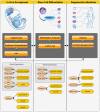LifeMap Discovery™: the embryonic development, stem cells, and regenerative medicine research portal
- PMID: 23874394
- PMCID: PMC3714290
- DOI: 10.1371/journal.pone.0066629
LifeMap Discovery™: the embryonic development, stem cells, and regenerative medicine research portal
Abstract
LifeMap Discovery™ provides investigators with an integrated database of embryonic development, stem cell biology and regenerative medicine. The hand-curated reconstruction of cell ontology with stem cell biology; including molecular, cellular, anatomical and disease-related information, provides efficient and easy-to-use, searchable research tools. The database collates in vivo and in vitro gene expression and guides translation from in vitro data to the clinical utility, and thus can be utilized as a powerful tool for research and discovery in stem cell biology, developmental biology, disease mechanisms and therapeutic discovery. LifeMap Discovery is freely available to academic nonprofit institutions at http://discovery.lifemapsc.com.
Conflict of interest statement
Figures








References
-
- West MD, Mason C (2007) Mapping the human embryome: 1 to 10e13 and all the cells in between. Regen Med 2: 329–333. - PubMed
-
- Geffers L, Herrmann B, Eichele G (2012) Web-based digital gene expression atlases for the mouse. Mamm Genome 23: 525–538. - PubMed
-
- Hackney JA, Moore KA (2005) A functional genomics approach to hematopoietic stem cell regulation. Methods Mol Med 105: 439–452. - PubMed
MeSH terms
LinkOut - more resources
Full Text Sources
Other Literature Sources

